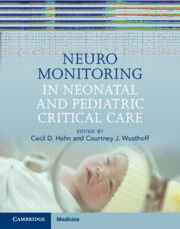Book contents
- Neuromonitoring in Neonatal and Pediatric Critical Care
- Reviews
- Neuromonitoring in Neonatal and Pediatric Critical Care
- Copyright page
- Contents
- Contributors
- Acknowledgements
- Part I General Considerations in Neuromonitoring
- Part II Practice of Neuromonitoring: Neonatal Intensive Care Unit
- Chapter 7 Neonatal Encephalopathy
- Chapter 8 Neonatal Seizures Due to Acute Causes
- Chapter 9 Neonatal Onset Epilepsy
- Part III Practice of Neuromonitoring: Pediatric Intensive Care Unit
- Part IV Practice of Neuromonitoring: Cardiac Intensive Care Unit
- Part V Cases
- Index
- References
Chapter 9 - Neonatal Onset Epilepsy
from Part II - Practice of Neuromonitoring: Neonatal Intensive Care Unit
Published online by Cambridge University Press: 08 September 2022
- Neuromonitoring in Neonatal and Pediatric Critical Care
- Reviews
- Neuromonitoring in Neonatal and Pediatric Critical Care
- Copyright page
- Contents
- Contributors
- Acknowledgements
- Part I General Considerations in Neuromonitoring
- Part II Practice of Neuromonitoring: Neonatal Intensive Care Unit
- Chapter 7 Neonatal Encephalopathy
- Chapter 8 Neonatal Seizures Due to Acute Causes
- Chapter 9 Neonatal Onset Epilepsy
- Part III Practice of Neuromonitoring: Pediatric Intensive Care Unit
- Part IV Practice of Neuromonitoring: Cardiac Intensive Care Unit
- Part V Cases
- Index
- References
Summary
Neonatal onset epilepsies are infrequent compared with neonatal seizures caused by acute symptomatic etiologies. Etiologies of neonatal epilepsies are classified into structural, genetic, and metabolic causes. EEG and amplitude-integrated EEG (aEEG) are essential for the diagnosis and monitoring of these conditions. EEG/aEEG findings often differ substantially among infants; unusual findings, such as downward seizure patterns on aEEG, can be found. Focal-onset seizures are very frequent, and epileptic spasms are infrequently observed. Myoclonic seizures with ictal EEG correlates and generalized tonic seizures are exceptional. Although burst suppression is known as the EEG hallmark of early infantile epileptic encephalopathy (EIEE) and early myoclonic encephalopathy (EME), the definition of “burst suppression” differs among researchers. Additional information is necessary to better understand the EEG/aEEG findings related to neonatal epilepsies and to clarify their utility in the diagnosis of neonatal epilepsies and monitoring the efficacy of treatment.
Keywords
- Type
- Chapter
- Information
- Neuromonitoring in Neonatal and Pediatric Critical Care , pp. 126 - 136Publisher: Cambridge University PressPrint publication year: 2022

